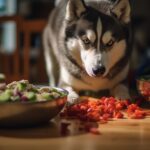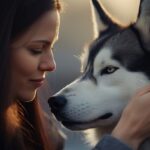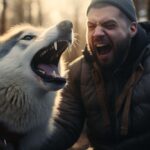Tails and Tales: Demystifying the Canine Conundrum
Welcome, fellow dog lovers and ardent Husky enthusiasts! If you’re reading this, chances are you’ve found yourself at the receiving end of your Husky’s destructive chewing habit. Perhaps, it was your favorite pair of shoes that fell victim to those pearly whites or, the Moby Dick of all chewable things, your beloved couch. Oh yes, I’ve been there. I speak from experience when I say that the sight of your husky, innocently sprawled out amidst a sea of couch stuffing, wouldn’t be as heartbreakingly adorable if it wasn’t your third couch this year.
Now, grabbing your Husky by the scruff and declaring, “No more couch for you, mister!” might be the right thing to do. But let’s paws for a moment and consider that there may be more to this canine problem than meets the eye. After all, your Husky isn’t a furry terminator sent from the future to destroy your furniture. It’s just doing what comes naturally to it—chewing.
This article will sink our teeth into why Huskies need to nibble, chew, and generally wreak havoc on inanimate objects. Through anecdotal tales and research-backed insights, we aim to understand your Husky’s behavior better and arm you with practical strategies to curb their destructive chewing habit. So buckle up, dog lovers! It will be a barking-mad ride into the world of Huskies, their practices, and how to live harmoniously (and furniture intact) with these beautiful creatures.
Understanding Your Husky’s Habits
Oh, the joys of owning a Husky! You’ve stepped into a world of snow-like fur all over your dark clothes, impromptu howling sessions in the middle of the night, and a love so deep it rivals the Mariana Trench. But now, you’re navigating the chewed-up aftermath of what used to be your favorite pair of shoes. Let’s dig into the ‘why,’ ‘how,’ and ‘what now’ of your Husky’s destructive chewing habits, shall we?
Canine Communication: Decoding your Husky’s behavior
Newsflash: Your Husky doesn’t chew up your belongings because they have a vendetta against your fashion choices. Nope! Chewing is a form of canine communication, a grand theatrical performance, if you will, of their emotional and physical state. It’s their way of saying, “Hey human, I’m bored!” or “Ouch, my gums hurt!” or even “I’m anxious, help!” So, before you put your Husky on trial for ruining your belongings, remember, they’re not chewing out of spite but out of a need to express something.
The Teething Troubles: Teething Impact on Husky Puppies
Just like human babies, Husky puppies also go through the teething phase. Picture this: your adorable fur baby is experiencing a mouthful of discomfort as their new teeth ambitiously try to break through the gum line. Ouch! This teething process can cause your Husky pup to chew on everything in sight to alleviate gum discomfort. So, if your slippers have been the unfortunate victim of this teething phase, don’t fret. It’s not about your slippers; it’s about those pesky teeth!
Boredom or Anxiety? Emotional Triggers Behind Destructive Chewing
Your Husky is an intelligent, energetic, and emotional creature. They’re like the Einsteins of the canine world, with a dash of Usain Bolt and a sprinkle of Shakespeare. Meaning they need mental stimulation, physical exercise, and emotional reassurance. Without these, Huskies can resort to destructive chewing out of boredom or anxiety.
So, if your Husky is turning your home into a chew toy heaven, it might be time to evaluate if they’re getting enough exercise, mental stimulation, and affection. Are they getting enough play time? Are you leaving them alone for long periods? Are there any changes in the household causing them anxiety? It’s like playing detective, but you’re decoding your Husky’s emotional state instead of solving a crime.
So, there you have it, dear Husky enthusiast! Understanding your Husky’s chewing habits is like learning a new language. It takes patience and practice, but you’ll have a stronger bond with your Husky once you decode it. And remember, the path to understanding is littered with chewed-up shoes, but it’s all worth it when you get those love-filled, ice-blue stares from your furry buddy.
Husky-Proofing Your Home: A Survival Guide for Your Slippers (and Sanity)
Picture this: It’s been a long day; you finally sit down to relax and… crunch… there goes another remote control. If you’re nodding along in knowing despair, then congrats! You’re a proud Husky parent. But fear not, fellow Husky lover, because I’m about to spill the secrets to a harmonious, chew-free home.
The Art of Distraction: Making Your Prized Possessions Less Appealing Than a Squeaky Toy
Now, Huskies aren’t just smart; they’re canine Einsteins. So, fooling them into ignoring your prized possessions is challenging. But here’s the secret sauce: Make their toys more appealing than your Italian leather shoes.
First, try stuffing a Kong toy with their favorite treats. Huskies are working dogs, and they love a good challenge. A stuffed Kong toy can keep them engaged for hours, and let’s be honest, it’s a lot more entertaining to watch them wrestle with a Kong toy than your favorite throw pillow.
Oh, and a quick tip: Rotate toys weekly. Huskies are like toddlers with a short attention span. A ‘new’ toy every week works like a charm.
Creating a Chew-Safe Zone: Your Husky’s Personal Chew-topia
Setting up a ‘chew-safe’ zone is like giving your Husky their chew-topia. Every item is up for grabs in this space, and no shoe or remote is in danger.
Start by selecting a space that’s away from anything valuable. A playpen or a corner of a room works great. Fill it with chew toys of different textures and shapes. Remember, variety is the spice of a Husky’s life.
And be consistent. Whenever you catch your furry Einstein heading towards your prized possessions, gently guide them back to their chew-topia. They’ll get the hint eventually. Probably.
The Great Outdoors: The Secret Weapon Against Destructive Chewing Habits
Here’s the hard truth. Nothing beats the great outdoors, no matter how many toys you provide or chew-safe zones you create. Limited exercise is one of the leading causes of destructive chewing in Huskies.
These furballs are born to run, and without regular exercise, your furniture might as well have a giant chew-me sign on it.
So, pack up those doggy bags, leash up your Husky, and hit the park. A tired Husky is a happy (and non-destructive) Husky.
In the end, remember that while Husky-proofing your home might take effort (and maybe a few sacrificed slippers), the love and companionship you get are worth every bit. After all, who can resist those blue eyes and mischievous smiles?
Choosing the Right Chew Toys
Hello, fellow Husky enthusiasts! Today, we’re diving into the fluffy, often toothy world of Husky chew toys. You know, those magical objects that can turn your energetic furball from a shoe-demolishing monster into a peacefully occupied pup? Yeah, those. So, let’s embark on this adventure together, where we’ll explore the chew toy checklist, test out some popular toys, and even dive into the DIY world. Hang onto your leashes, folks!
The Chew Toy Checklist: What to look for when buying chew toys for Huskies.
I know what you’re thinking, “A checklist for chew toys? Really?” But a little prep work can save your favorite slippers from an untimely demise. So, what should you look for?
- Durability: Your Husky’s chew toy should be as challenging as their personality. Soft toys might not hold up against those strong jaws. Look for ‘indestructible’ or ‘durable’ labels.
- Safety: You wouldn’t want your fur buddy to swallow harmful bits, would you? Opt for non-toxic materials and avoid toys with small, detachable parts.
- Size: Size matters! A small toy can be a choking hazard, while something too large might not be as fun for your Husky.
- Engagement: The best chew toys aren’t just chewable; they’re also attractive. Toys that squeak, bounce unpredictably, or hide treats can entertain your Husky for hours.
Now that you’re armed with this handy checklist let’s move on to the fun part.
Toy Testing: Sharing personal experiences and reviews of popular chew toys.
Have you ever had your Husky look at you like you’ve betrayed them when you handed over a chew toy they didn’t like? Yeah, me too. So, to save you from those heart-wrenching puppy eyes, I’ve tested some popular chew toys myself.
The KONG Classic Dog Toy – This one’s a crowd-pleaser. It’s durable and safe, and you can stuff it with treats. My Husky loves it, and I’m sure yours will, too.
The Nylabone DuraChew – This one is a bit of a mixed bag. It’s durable and comes in various flavors, but some Huskies aren’t fans. It’s worth a try, though!
The DIY Route: Fun and safe ideas for homemade chew toys.
If you’re feeling crafty, why not make a chew toy yourself? One of my favorites is the ‘Tennis Ball Muffin Tin Game.’ It involves a muffin tin, tennis balls, and treats. Hide the goodies in the container, cover them with tennis balls, and let your Husky have a ball – pun intended!
Remember, the key to a good chew toy is to keep your Husky entertained, engaged, and, most importantly, away from your shoes. Happy chewing, Husky lovers!
Training Techniques to Curb Destructive Chewing
Hello, fellow husky fanatics! Let’s discuss something we know too well: the great Husky chew-off. You know, the one where your beloved fur-baby decides your favorite pair of shoes is their new chew toy? Yes, that one. Don’t fret, though. I’m here to guide you through the world of husky training, specifically on how to curb destructive chewing. So, grab a cup of coffee (or tea, if that’s your thing), and let’s get into it!
Command Central: Teaching your Husky essential commands to stop chewing
First, your husky isn’t chewing your stuff to drive you bonkers (although it may feel that way). It’s a natural behavior for them. Should we accept it, our mission is to teach them what they can and can’t chew on.
Training your husky to follow commands like “leave it” and “drop it” can be a game-changer. Start by teaching these commands using toys (not the chewed remains of your favorite slippers). Remember, patience is vital. It’s like waiting for your coffee to brew in the morning; it may take some time, but the result is worth it!
Reward System: The role of positive reinforcement in curbing destructive habits
Positive reinforcement is the MVP of dog training. When your husky listens to a command or chooses their chew toy over your shoe, reward them with a treat, a pat, or a celebratory “Good dog!”. Imagine it as the equivalent of someone giving you a slice of cake every time you finish a task. You’d be pretty motivated.
Repetition is key here. It’s like your favorite sitcom rerun – the more you watch, the more the jokes sink in. The same applies to your husky. The more they’re rewarded for good behavior, the more they’ll repeat it.
When Things Go Wrong: Dealing with setbacks in the training process
Just like when you tried to make homemade sourdough during quarantine, things might not go as planned. Your husky might have a destructive relapse and decide that your new couch looks tasty.
Don’t panic! It’s important to remember that setbacks are a normal part of the training process. It doesn’t mean you’re failing as a husky parent. It’s a sign that you must adjust your approach and invest in chew-resistant furniture covers.
So there you have it, folks! The lowdown on training your husky to curb their destructive chewing habits. Remember, it’s all about patience, positive reinforcement, and understanding. After all, nobody’s perfect – not even our adorable, shoe-munching fur babies!
When to Seek Professional Help
Alright, fellow Husky lovers, let’s get serious for a moment. It’s not too serious; we’re still having fun here. But let’s talk about when Fido’s fondness for furniture (and shoes, and rugs, and…) might be more than just a quirky character trait.
Recognizing the Signs
Imagine you’re walking into your living room, and there it is: your favorite pair of sneakers, now a chewed-up shadow of their former selves. You sigh, but then you remember: “Hey, my Husky is just being a Husky, right?”
Well, yes and no. Our furry friends love a good chew, but it might be time to raise an eyebrow when it becomes an all-consuming (pun intended) hobby. Excessive chewing can sometimes be an indication of underlying issues like anxiety, boredom, or even dental problems. If your Husky is going through chew toys faster than a hot knife through butter, it might be time to seek some professional advice.
Consulting the Canine Experts
Now, when I say “professional advice,” I’m not suggesting you call in the doggy equivalent of the SWAT team. But chatting with a dog trainer or an animal behaviorist might be a good idea. These folks are like the Sherlock Holmes of the canine world, able to decipher the mysteries of dog behaviors that leave us mere mortals scratching our heads.
A behaviorist or trainer can help you identify the root cause of the excessive chewing and provide strategies to curb this behavior. They might suggest more mental stimulation, a different diet, or even a new chew toy. So don’t worry; it’s not like you’re signing your Husky up for boot camp or anything – unless that’s what they’re into, of course!
The Vet Visit
Finally, if your Husky’s chewing habit is accompanied by other signs – like changes in appetite, unusual behavior, or, heaven forbid, a tooth hanging by a thread – it’s time to take a trip to the vet. The vet is like the doggy doctor who can rule out any physical reasons for the excessive chewing.
Remember, we’re not just Husky enthusiasts but responsible Husky parents. And sometimes, being a good parent means knowing when to call in the experts. So please don’t hesitate to ask for help when you need it. After all, our primary goal is to keep our furry friends happy, healthy, and hopefully not chewing through our entire shoe collection!
So, fellow Husky lovers, keep your eyes peeled, your vet on speed dial, and maybe save a spare pair of shoes on hand, just in case!
Wrapping Up the Chew Chat
The Long Chew to Freedom
We’ve chewed the fat on this topic, folks, haven’t we? Let’s sink into a quick recap to ensure everything’s adequately digested. First, we discussed the ‘why’ behind your Husky’s destructive chewing. Remember, it isn’t because they’ve got a personal vendetta against your shoes or furniture but because it’s their way of exploring the world, dealing with anxiety or boredom, or soothing their teething woes.
Next, we dished out some bone-afide strategies to curb this destructive habit. These included providing chew toys, regular exercise, training, and heaps of love and patience. And let’s not forget that it should be your secret weapon, not a first-line defense when it comes to the’ No-Chew’ spray.
Final Thoughts
As we wrap up our chew chat, remember that Rome wasn’t built in a day, and your Husky won’t quit their chewing habit overnight. It’s a process, a journey. You’ll have moments of triumph and days when you’re back at square one. But as the saying goes, ‘Every dog has its day,’ and your Husky will have theirs too.
So, fellow Husky enthusiasts, as you embark on this ‘long chew to freedom,’ remember to keep your sense of humor intact, your patience unwavering, and your love for your furry friend overflowing. After all, even amidst the chaos and chewed-up shoes, there’s no denying that life is just better with a Husky by your side.
That’s all for now, folks. Keep those tails wagging; remember, every chew is a step closer to victory. Happy training!
Key Takeaways: Curbing Destructive Chewing
| Key Takeaway | Details |
|---|---|
| Understanding the Behavior | Chewing is a natural behavior for Huskies. It can be a way of exploring their environment, a response to teething or boredom, or a symptom of anxiety. |
| Importance of Exercise | Huskies are an active breed that requires a lot of exercise. Regular physical activity can help curb destructive chewing. |
| Proper Training | Teaching your Husky the ‘leave it’ or ‘drop it’ command can help control inappropriate chewing. Consistent, positive reinforcement is key. |
| Providing Appropriate Toys | Huskies need durable chew toys. Providing a variety of these can divert their chewing behavior from inappropriate items. |
| Avoid Punishment | Punishing your Husky for chewing may cause more harm than good, potentially leading to fear or anxiety. Instead, focus on redirecting their behavior. |
| Regular Vet Check-ups | Regular vet check-ups can help rule out any medical reasons for excessive chewing, such as dental problems or dietary deficiencies. |
| Mental Stimulation | Along with physical exercise, Huskies also need mental stimulation. Puzzle toys, training sessions, and social interaction can help prevent boredom, a common cause of destructive chewing. |
| Crate Training | Crate training can effectively control destructive chewing, especially when you’re not at home. However, it should be done properly to avoid causing stress or anxiety. |
Tips for Curbing Destructive Chewing
Hello there, fellow Husky aficionado! Have you ever found your favorite pair of shoes turned into a slobbery chew toy by your furry friend? If your answer is a teary-eyed “yes,” welcome to the club! But don’t worry, there’s light at the end of the chewed-up tunnel. Here are some tips to help save your precious belongings from the jaws of your Husky.
1. Invest in chew-proof toys: Let’s swap out those designer shoes with something less… um, expensive. How about some sturdy, chew-proof toys? Your Husky will love you for it. And hey, your shoes will too!
2. Keep valuables out of reach: If your Husky can’t reach that top shelf, think again. These furry acrobats can leap to heights you’d never imagine. So, unless you want your Husky to be the next Houdini, keeping your valuables out of their reach is best.
3. Exercise is vital: A bored Husky is a chewing Husky. Make sure your four-legged friend gets enough exercise to tire them out. An exhausted Husky is less likely to turn your sofa into a chew toy. And guess what? You’ll get in great shape, too!
4. Positive reinforcement: Reward your Husky when they chew on their toys, not your furniture. A simple “good dog” and a belly rub can work wonders. And if that doesn’t do the trick, there’s always the secret weapon – treats!
5. “Dog-proof” your home: This is like baby-proofing but with more fur and saliva. Make sure chewable items (I’m looking at you, remote controls) are stored away correctly. Your Husky won’t chew what they can’t find, right?
6. Consult a professional: If your Husky is auditioning for the next Jaws movie with your furniture, it might be time to call a professional. Dog trainers or behaviorists can provide personalized techniques to curb your Husky’s chewing habit.
Remember, your Husky isn’t chewing to spite you. They’re just energetic and curious creatures with an instinct to chew. It’s no walk in the park, but you can turn your destructive chewer into a well-behaved pup with patience, consistency, and a dash of humor. And always remember, the love of a Husky is worth every chewed-up shoe!






